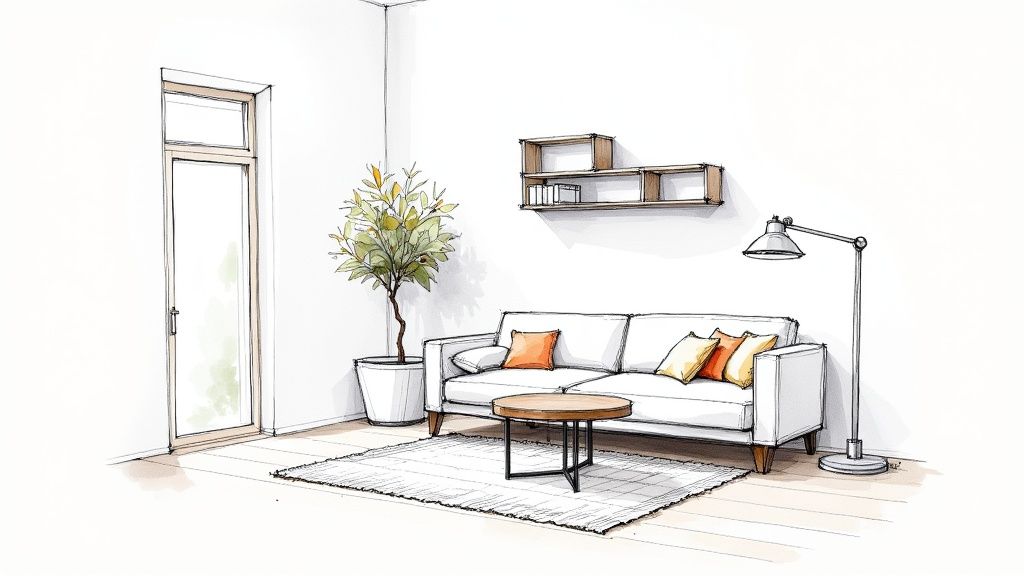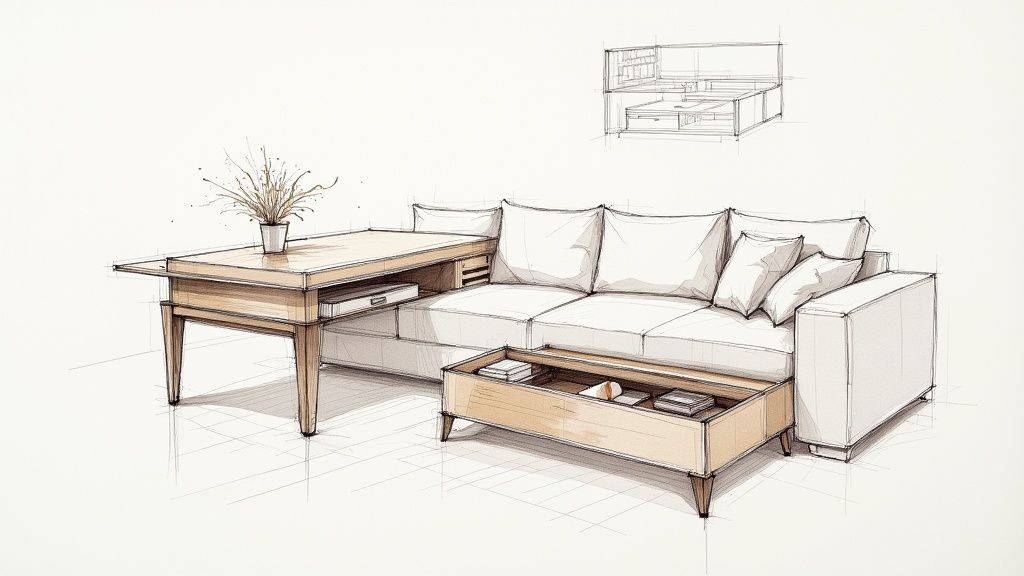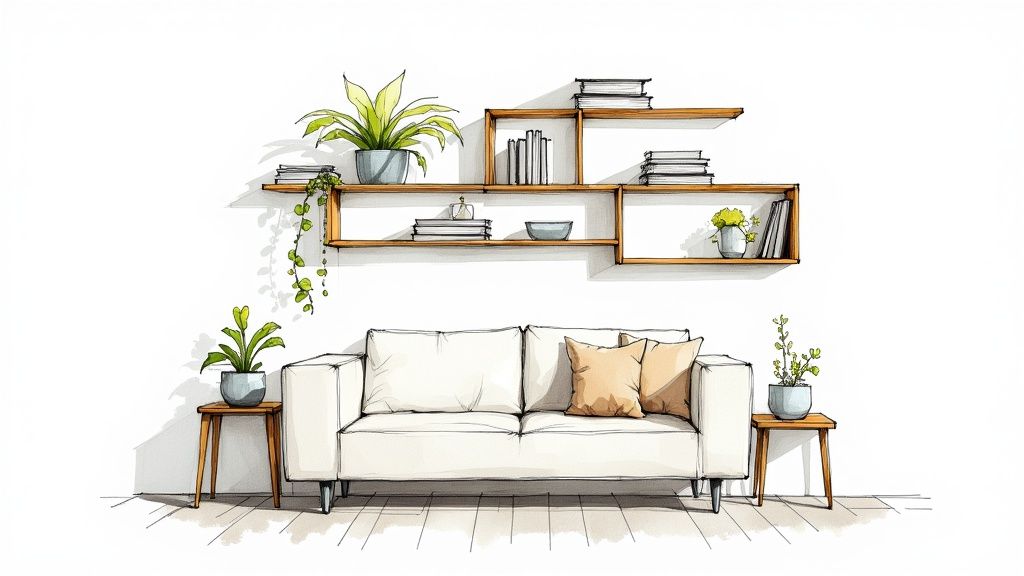
Stylish furniture for your small living room: An Actionable Guide
Choosing the right furniture for your small living room is a game-changer. It can transform a room from tight and awkward to a masterclass in smart, stylish design. The secret isn't cramming in the smallest items you can find. It’s about choosing pieces with the right proportions, clever multifunctionality, and a visually light feel. Get this right, and you'll create an inviting, organised living space that feels open and breathes with you, no matter the square meterage.
The Art of Designing a Small Living Room
Let go of the idea that a small living room is a problem to be solved. Think of it instead as a canvas for creative and intelligent thinking. This guide will show you how to apply the Italian philosophy of furnishing compact spaces, where elegance and everyday practicality go hand in hand. We’re going to shift your perspective from feeling restricted to seeing all the possibilities. A small room, designed with care, can be the stylish, functional, and warm heart of your home. The magic isn't in the size of a space; it's in the cleverness of its design.
This isn’t just a niche idea; it’s a reflection of how we live today. As our homes, especially in cities, become more compact, the need for furniture that does more has skyrocketed. Living room furniture is the biggest single category in Italy's home furnishings market, projected to hit US$17.64 billion by 2025. What’s driving this growth? A huge consumer shift towards multifunctional, space-saving designs that refuse to compromise on style. You can discover more insights about the Italian furniture market and see how it’s evolving. This trend is proof that people are actively looking for solutions that blend beauty and brains.
Shifting Your Mindset
The first step is to see your room differently. Stop focusing on what you can't fit, and start planning what you can create. A smaller space forces you to be intentional. Every piece of furniture must earn its spot.
"A compact living room doesn’t mean you have to compromise on style or comfort. With the right furnishings, pale colours and effective lighting, you can transform even the smallest spaces into welcoming and functional environments."
Start thinking of your room as a carefully curated gallery, not just a place to put things. This mindset will guide you to prioritise items that are both beautiful and genuinely useful, helping you sidestep the clutter that shrinks a small room in an instant.
Core Principles for Success
Before you start shopping, ground your decisions in a few key principles. These will act as your compass, guiding every choice to ensure your living room feels cohesive, airy, and wonderfully practical.
- Embrace the Double-Duty Hero: Seek out furniture that performs more than one job. Actionable examples include an ottoman with hidden storage, a coffee table that lifts to become a desk, or a chic sofa bed for guests.
- Go Vertical: Use your walls to create the illusion of more height. Install tall, slender bookcases or floating shelves. Hang your curtains from the ceiling down to the floor to make the room feel much grander.
- Let There Be Light: Use light, both natural and artificial, to your advantage. Place a large mirror opposite a window to bounce sunlight around the room. Choose lighter-coloured furniture and layer your lighting with a mix of floor lamps, table lamps, and wall sconces to add depth and warmth.
Choosing Your Foundational Furniture
Selecting the core mobili per soggiorno piccolo is where your vision truly starts coming to life. This isn't just about measurements; it's a balance of form, function, and feeling. The foundational pieces—your sofa, coffee table, and media unit—are the anchors of the room. Choosing them with care is the most important step in creating a space that feels both open and uniquely yours.
Let's debunk a common myth: small rooms don't automatically need tiny furniture. It's all about proportion. In fact, one well-chosen, slightly larger piece can make a room feel grander and less cluttered than a collection of small, disconnected items. The secret is in understanding visual weight and championing intelligent design.
The Sofa Your Space Deserves
The sofa is the heart of the living room and usually the largest piece. Getting it right is critical. In a compact space, you need a sofa that delivers on comfort without visually swallowing the room. Look for a model with a lighter, more graceful footprint.
A sofa raised on slender legs is a game-changer. It allows light and air to flow underneath, creating an immediate illusion of more space. This trick lets you see the floor extending beneath it, which our brains interpret as a larger room. It's a classic designer move for a reason
When considering style, look for sofas with low-profile arms or armless designs. These models take up less physical space and create a more streamlined, modern vibe. Fabric choice is also crucial. Lighter colours in neutral tones—soft grey, cream, or warm beige—reflect light and visually recede, making the sofa feel much less imposing.
Coffee Tables and Media Units That Enhance Flow
Once your sofa is in place, pick complementary pieces that support the room's flow. Your coffee table and media unit should be active partners in your space-saving strategy.
For coffee tables, focus on shape and material. A round or oval table lacks sharp corners, making navigation in a tight space much easier. It’s a subtle change that can dramatically improve how it feels to move around the room.
A transparent coffee table made of glass or acrylic is a fantastic trick. It performs its function without adding any visual bulk, almost disappearing into the room. This keeps the sightline open across the floor, which is essential for creating a sense of spaciousness.
Your media unit deserves equal thought. Avoid huge, heavy entertainment centres. Instead, opt for a low-profile console that’s wider than it is tall. This draws the eye horizontally, making the room feel wider. Even better are wall-mounted units that free up floor space entirely, creating a floating effect that feels incredibly light and airy.
For a cohesive look rooted in elegant Italian design principles, explore curated collections of minimalist furniture. Finding pieces that speak the same design language will unify your space beautifully. For some fantastic ideas, check out this selection of design furniture for modern interiors from creators who understand the balance between style and craftsmanship.
Smart Furniture Choices for Small Living Rooms
Seeing the options side-by-side makes all the difference. Understanding the specific benefits of space-savvy alternatives will empower you to choose furniture that actively works to make your small living room feel larger.
| Standard Furniture | Space-Saving Alternative | Key Benefit |
|---|---|---|
| Bulky Sofa with Skirt | Sofa on Slender Legs | Creates an illusion of more floor space and airiness. |
| Square Wooden Coffee Table | Round Glass or Acrylic Coffee Table | Eases movement and reduces visual clutter. |
| Large Entertainment Centre | Low-Profile or Floating Media Unit | Frees up wall and floor space, making the room feel wider. |
| Traditional Armchair | Armless Slipper Chair | Provides extra seating with a much smaller physical footprint. |
Ultimately, choosing these foundational pieces is about making deliberate, intelligent decisions. It’s about seeing the potential in every centimetre and picking items that aren't just beautiful, but are also perfectly scaled for your home. By putting visual lightness, proportion, and smart design first, you’re laying the groundwork for a small living room that is anything but limited.
Let Your Furniture Work For You: The Magic of Multifunctional & Modular Pieces
This is where the fun begins. Furnishing a soggiorno piccolo is a creative challenge, a masterclass in clever, efficient design. Forget furniture that just sits there. Start thinking about every piece as an active participant that doesn't just take up space, but actually creates it.
The goal is simple: make every item count. We’re moving beyond single-purpose pieces and embracing furniture that pulls double, even triple, duty. This is how you transform a compact living room into a masterclass of function and style, making a small space feel limitless.
The Power of Double-Duty Furniture
Think of multifunctional furniture as the secret weapon in your design toolkit. These are the heroes that bring order and surprising versatility to a snug room. They solve problems, save space, and often become the most talked-about pieces in your home.
The classic storage ottoman is a perfect example. On the surface, it’s a comfy footrest or an extra seat. Lift the lid, and it’s the perfect hideaway for blankets, magazines, or kids' toys. It’s a design staple for a reason—it elegantly combines comfort with clutter control.
Another star performer is the lift-top coffee table. It sits looking like a standard table, but with one simple motion, it transforms into a proper workstation or a dining surface for a relaxed meal on the sofa. It’s the ultimate chameleon, adapting to your life from one moment to the next.
The true beauty of multifunctional furniture lies in its ability to give you all the perks of a larger home within a much smaller footprint. It empowers you to live fully and comfortably, no matter the square meterage.
This isn’t just a passing trend; it's a real shift in how we live. Italy’s living room furniture market is projected to be worth around US$3.31 billion in 2025, driven by a clear preference for functional, modern designs. Italian shoppers are increasingly drawn to pieces like extendable tables and modular sofas that solve real-world space problems. You can discover more insights about these living room furniture trends and see just how our lifestyles are shaping the market.
Embracing Modular Flexibility
While multifunctional pieces serve many purposes, modular furniture offers a different superpower: the freedom to change and adapt. Modular systems are built from individual sections that you can arrange, rearrange, and even add to over time. They're the perfect answer for awkwardly shaped rooms or for anyone whose needs might evolve.
A modular sofa is a fantastic long-term investment. You can start with a simple two-seater and add a chaise longue later. You can completely reconfigure it to fit a new apartment or to create a different vibe for entertaining.
Modular shelving is another game-changer. Instead of one bulky bookcase, you can create a custom storage solution that feels made for your space. Here’s how to make it work:
- Go vertical: Build your shelving upwards to draw the eye up, creating an illusion of height while keeping the floor clear.
- Wrap around corners: Use purpose-built corner units to turn awkward nooks into practical storage.
- Create visual interest: Mix open shelves with closed cabinets. This gives you a place to display favourite objects while hiding away less beautiful essentials.
This flexibility means your furniture can grow with you, adapting to your life instead of forcing you to adapt to it.
Inspiring Real-World Examples
Here’s how these pieces work in a real soggiorno piccolo:
Scenario 1: The Studio Apartment Solution
In a studio, your living room is also your bedroom. A high-quality divano letto (sofa bed) is a must. Modern designs are comfortable enough for daily use and stylish enough to be a centrepiece. Pair it with a sleek, wall-mounted media unit that "floats" above the ground, and the whole space feels open and uncluttered, transitioning effortlessly from day to night.
Scenario 2: The Long, Narrow Living Room
For a long, thin room, a set of nesting tables is a stroke of genius. Tuck them away to save space day-to-day, then pull them apart to serve drinks and snacks when friends come over. This avoids the visual weight of a single, large coffee table. Complement them with floating shelves on the walls to display books and decor without eating into your precious floor space.
By choosing these hardworking pieces, you aren't just filling a room; you're designing a smarter, more responsive home. You're making every square centimetre work for you, creating a space that is as functional as it is beautiful.
Arranging Furniture for Flow and Function
You can pick the most beautiful mobili per soggiorno piccolo, but if they aren't arranged thoughtfully, the room will never feel right. This is where the real magic happens. It’s not about cramming furniture in; it’s about creating a living space that flows, feels intuitive, and invites you in. A great layout can single-handedly make a small room feel spacious and welcoming.

First, establish clear pathways. When you walk into the room, can you get to the sofa or the window without sidestepping a coffee table? Your action plan should be to leave at least 75-90 centimetres of open space for major walkways. This simple rule will stop your living room from feeling like a cluttered obstacle course.
Creating Cohesive Zones
Even in the smallest living rooms, creating distinct "zones" gives the space a sense of purpose and order. Your main zone is usually the conversation area, anchored by your sofa and chairs.
An area rug is your most effective tool for defining this space. A well-chosen rug visually corrals your seating, pulling everything together into a unified whole. A key tip is to ensure at least the front legs of your sofa and armchairs are sitting on the rug. This grounds the arrangement and makes it feel deliberate.
The biggest mistake is pushing furniture tight against every wall. Pull your sofa and chairs even a few centimetres away from the walls. This 'pull-away' technique creates breathing room that makes the entire space feel larger and more sophisticated.
It seems counterintuitive, but that little gap creates shadows and a sense of depth. It’s a designer’s secret that instantly makes a room feel more airy and less like a box.
Strategic Layouts for Common Shapes
Most of us don't have perfectly square rooms. Awkward layouts are a common challenge, but they also present a creative opportunity. Here are some solutions:
- The Long, Narrow Room: To avoid the "bowling alley" effect, don't line everything up along the long walls. Instead, divide and conquer. Create your primary seating group at one end, and use the other for a secondary purpose—like a cosy reading nook with a comfy chair and a lamp, or a slim console table for a mini workspace.
- The Square Room: This shape can sometimes feel static. Inject life into it by breaking up the symmetry. Angle an armchair in one corner to create a focal point, or arrange your seating in a U-shape to encourage conversation and make the layout feel more dynamic.
The Finishing Touch of Light and Decor
Lighting has a massive impact on how the layout feels. A single overhead light tends to flatten everything. The key is to layer your lighting. Add a floor lamp in a corner and a table lamp on a side table—these pools of light create warmth, depth, and a much more inviting atmosphere.
Finally, bring in your accessories, but be selective. A few well-chosen pieces are far better than a dozen small, cluttered items. Think about a striking centrepiece for the coffee table or a beautiful object on a bookshelf. For inspiration, a collection of modern decorative sculptures can add personality without taking up precious space. These final details guide the eye through the room and reinforce the sense of flow you've worked so hard to create.
Accessorizing Without Creating Clutter
This is where you breathe life into the room, transforming a collection of furniture into a home that tells your story. It’s all about adding character in a way that enhances, rather than overwhelms, your mobili per soggiorno piccolo.

This final layer is where your personality shines. In a small room, every choice matters. The guiding principle is simple but powerful: less is more, but make the 'less' count.
The Strategic Power of Mirrors and Verticality
You’ve probably heard the advice to "use mirrors," but the secret is in the why and the where. A large mirror isn't just a pretty object; it's a tool for manipulating light and perception.
Place a large mirror directly opposite your main window. This is one of the most impactful moves you can make. It essentially creates a second window, grabbing natural light and bouncing it back into the room. This simple trick can almost double the brightness, creating a profound sense of openness.
Just as important is drawing the eye upward. When your floor space is limited, your walls become your greatest asset. By introducing vertical elements, you trick the brain into perceiving a higher ceiling and a grander space. Here are actionable ways to do this:
- Floor-to-Ceiling Curtains: Mount your curtain rod as close to the ceiling as possible and let the fabric fall all the way to the floor. This creates a stunning, unbroken vertical line that adds instant height.
- Tall, Slender Plants: A fiddle-leaf fig or a snake plant in a slim pot draws attention upward and brings organic life into the room without devouring floor space.
- Vertical Art Arrangements: Instead of one large horizontal painting, create a gallery wall of smaller frames arranged in a tall, vertical column to achieve the same eye-lifting effect.
Curating Textiles for Texture and Warmth
Textiles bring softness, colour, and personality, but in a compact area, they need to be chosen with a careful eye. The goal is to add lovely layers of texture without adding bulk or visual chaos.
Think of your cushions, throws, and rug as a family—they don’t need to match perfectly, but they should speak the same language. A cohesive colour palette is your best friend.
"A unified colour scheme doesn’t mean a boring one. By selecting textiles in varying shades and textures of two or three core colours, you create a sophisticated, serene environment that feels intentional and uncluttered."
For instance, if your sofa is soft grey, layer it with cushions in charcoal, deep slate blue, and creamy white. Then, add a chunky knit throw in a similar blue tone. The varied textures add visual interest, while the consistent palette keeps everything feeling calm.
An area rug will anchor your arrangement, but ensure it's the right size. A rug that’s too small will make the room feel disjointed. As mentioned, the front legs of your main furniture should sit comfortably on it to unify the entire zone.
The Art of Selecting Meaningful Objects
Now for the best part: the personal touches that make the space truly yours. The key here is curation, not collection. Resist the urge to fill every surface. Instead, choose a few items that you love and give them space to breathe.
This is your chance to showcase your style with a beautifully crafted decorative piece. Instead of a dozen small trinkets, a single, elegant vase can make a much stronger statement. You can find incredible inspiration by exploring collections of unique and artistic decorative vases that are essentially pieces of art. One or two of these on a floating shelf or a side table can add that perfect touch of Italian design and sophistication without ever feeling like clutter.
This thoughtful approach reflects broader Italian consumer trends. Sustainability and smart design are huge forces in the mobili per soggiorno piccolo sector, with a real demand for eco-friendly materials and mindful production. Wood remains the star, holding a dominant 61.85% share of the Italian furniture market, showing a deep appreciation for well-crafted items over mass-produced clutter. By choosing accessories with intention, you're not just decorating; you're creating a curated sanctuary.
A Few Final Questions on Small Living Room Furniture
When you're trying to perfect the look of your mobili per soggiorno piccolo, a few common questions always pop up. Let's tackle them head-on with direct, actionable answers.
What Are the Best Colours for a Small Living Room?
Stick to light, bright, and airy colours. Soft whites, elegant beiges, light greys, and faint pastels are your best options. These shades are masters at bouncing light around a room, making a space feel bigger and more open.
To avoid a boring look, start with a neutral canvas for your walls and large furniture like the sofa. Then, layer in personality with vibrant pops of colour through bold cushions, a richly textured throw, or a single armchair in a deep jewel tone. A monochromatic scheme, using different shades of the same colour, also creates a sophisticated and spacious feel.
How Can I Add Storage Without Creating Clutter?
The solution is to choose smart, multi-functional furniture that hides your things away while keeping the room's profile sleek.
Make your furniture work harder with these specific choices:
- A storage ottoman: Use a model with a lift-up top to stash blankets or magazines.
- A functional coffee table: Look for one with built-in drawers or a lower shelf.
- A closed media console: Select a unit that keeps all your electronics and cables neatly out of sight.
And don't forget to look up! Use your vertical space. Tall, slim bookcases or floating shelves draw the eye upward and free up floor space. Here’s a pro tip: pick mobili contenitori (storage furniture) that are the same colour as your walls. They will blend into the background, instantly reducing their visual footprint.
Should I Use One Large Rug or Several Small Ones?
Always choose one large rug for a smaller living room. A single, generous rug that fits under the front legs of your sofa and armchairs works wonders. It pulls the seating area together, creating a unified zone that makes the entire room feel more expansive and cohesive.
Using several small rugs often has the opposite effect. It chops up the floor visually, making the space feel fragmented and even smaller. A single large rug acts as an anchor, defining your space and giving it a polished, well-thought-out foundation.
What Kind of Lighting Works Best?
Layering your lighting is essential. Relying on a single, harsh overhead light is a mistake that casts unflattering shadows and makes a room feel one-dimensional. The secret is to mix different light sources to create depth and atmosphere.
Plan your lighting in three distinct layers:
- Ambient Lighting: This is your room’s main light source, like a stylish flush-mount ceiling fixture or subtle recessed lights.
- Task Lighting: This is light for specific activities. A sleek floor lamp beside your reading chair is a perfect example.
- Accent Lighting: These are pools of light that bring warmth and character, such as a small lamp on a side table or a pair of well-placed wall sconces.
By combining these layers, you not only get a room that functions better but also gain control over the mood, creating a warm, inviting glow that makes your small space feel dynamic and welcoming.
Discover how Griseo Interior can help you find the perfect minimalist accents and design furniture to bring your small living room to life. Explore our collection of Italian-designed pieces, crafted with care to elevate your home. Visit us today at https://griseointerior.com.
